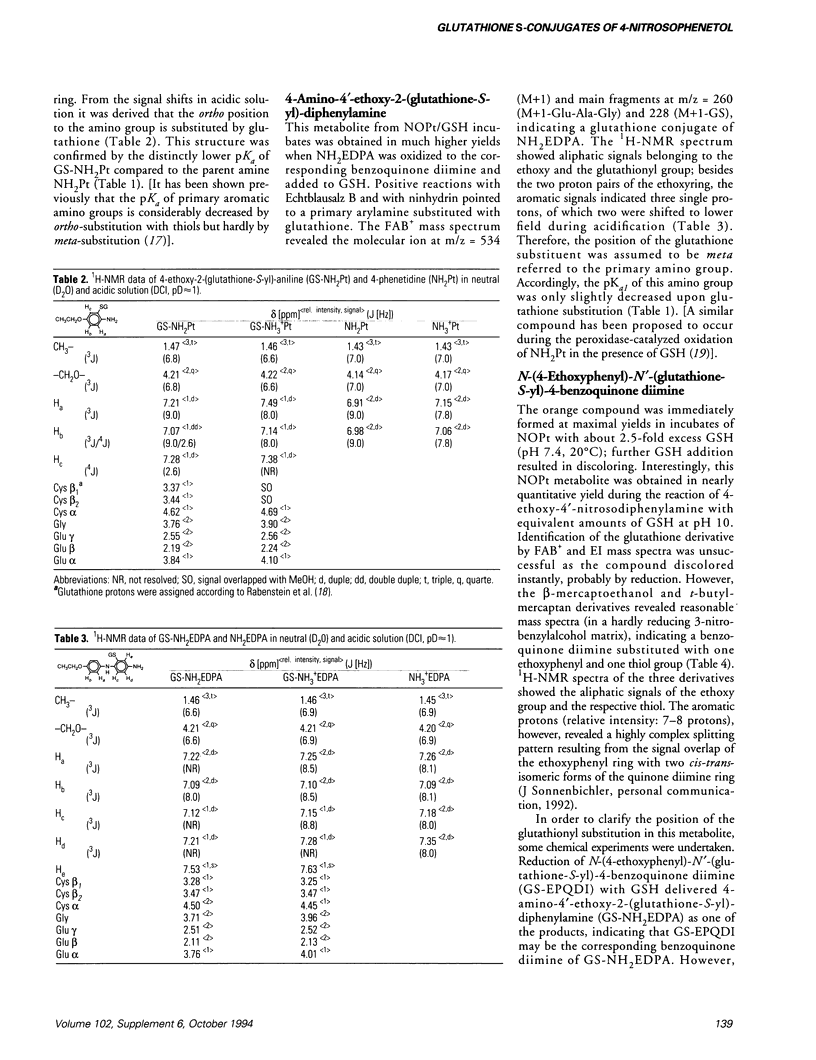Abstract
During the well-established reaction pathways of nitrosoarenes interacting with thiols, a reactive N-(thiol-S-yl)-arylamine cation was implicated in the so-called rearrangement reaction which transforms the semimercaptal to the sulfinamide. In the case of nitrosoarenes with pi-donating substituents, this cationic transition state includes resonance structures bearing the positive charge in 2 and 4 position, thereby facilitating the attack of nucleophiles to the aromatic ring. Investigating the reaction products of 4-nitrosophenetol and reduced glutathione in chemical systems and human red cells, some glutatione S-conjugates were detected other than the already known sulfenamide and sulfinamide. Three of them were separated by HPLC and identified by mass spectroscopy, 1H-NMR, and UV-visible spectroscopy, by determination of pKa values and chemical behavior. The hitherto unknown conjugates are 4-ethoxy-2-(glutathione-S-yl)-aniline, N-(4-ethoxyphenyl)-N'-(glutathione-S-yl)-benzoquinonediimine, and 4-amino-4'-ethoxy-2-(glutathione-S-yl)-diphenylamine. In preliminary experiments, some of these conjugates were shown to be highly active in producing ferrihemoglobin. Considerations on the formation pathways of these metabolites lend further support to the electrophilic N-(glutathione-S-yl)arylamine cation as a reactive intermediate that may be implicated in nitrosoarene toxicity.
Full text
PDF





Selected References
These references are in PubMed. This may not be the complete list of references from this article.
- Dölle B., Töpner W., Neumann H. G. Reaction of arylnitroso compounds with mercaptans. Xenobiotica. 1980 Jul-Aug;10(7-8):527–536. doi: 10.3109/00498258009033787. [DOI] [PubMed] [Google Scholar]
- Eckert K. G., Eyer P., Sonnenbichler J., Zetl I. Activation and detoxication of aminophenols. II. Synthesis and structural elucidation of various thiol addition products of 1,4-benzoquinoneimine and N-acetyl-1,4-benzoquinoneimine. Xenobiotica. 1990 Apr;20(4):333–350. doi: 10.3109/00498259009046851. [DOI] [PubMed] [Google Scholar]
- Ellis M. K., Hill S., Foster P. M. Reactions of nitrosonitrobenzenes with biological thiols: identification and reactivity of glutathion-S-yl conjugates. Chem Biol Interact. 1992 Apr 15;82(2):151–163. doi: 10.1016/0009-2797(92)90107-v. [DOI] [PubMed] [Google Scholar]
- Eyer P., Ascherl M. Reactions of para-substituted nitrosobenzenes with human hemoglobin. Biol Chem Hoppe Seyler. 1987 Mar;368(3):285–294. doi: 10.1515/bchm3.1987.368.1.285. [DOI] [PubMed] [Google Scholar]
- Eyer P., Hertle H., Kiese M., Klein G. Kinetics of ferrihemoglobin formation by some reducing agents, and the role of hydrogen peroxide. Mol Pharmacol. 1975 May;11(3):326–334. [PubMed] [Google Scholar]
- Eyer P. Reactions of nitrosobenzene with reduced glutathione. Chem Biol Interact. 1979 Feb;24(2):227–239. doi: 10.1016/0009-2797(79)90011-5. [DOI] [PubMed] [Google Scholar]
- Eyer P. Reactions of oxidatively activated arylamines with thiols: reaction mechanisms and biologic implications. An overview. Environ Health Perspect. 1994 Oct;102 (Suppl 6):123–132. doi: 10.1289/ehp.94102s6123. [DOI] [PMC free article] [PubMed] [Google Scholar]
- Gallemann D., Eyer P. Effects of the phenacetin metabolite 4-nitrosophenetol on glycolysis and pentose phosphate pathway in human red cells. Biol Chem Hoppe Seyler. 1993 Jan;374(1):37–49. doi: 10.1515/bchm3.1993.374.1-6.37. [DOI] [PubMed] [Google Scholar]
- Gallemann D., Eyer P. Effects of the phenacetin metabolite 4-nitrosophenetol on the glutathione status and the transport of glutathione S-conjugates in human red cells. Biol Chem Hoppe Seyler. 1993 Jan;374(1):51–60. doi: 10.1515/bchm3.1993.374.1-6.51. [DOI] [PubMed] [Google Scholar]
- Klehr H., Eyer P., Schäfer W. Formation of 4-ethoxy-4'-nitrosodiphenylamine in the reaction of the phenacetin metabolite 4-nitrosophenetol with glutathione. Biol Chem Hoppe Seyler. 1987 Aug;368(8):895–902. doi: 10.1515/bchm3.1987.368.2.895. [DOI] [PubMed] [Google Scholar]
- Klehr H., Eyer P., Schäfer W. On the mechanism of reactions of nitrosoarenes with thiols. Formation of a common intermediate "semimercaptal". Biol Chem Hoppe Seyler. 1985 Aug;366(8):755–760. doi: 10.1515/bchm3.1985.366.2.755. [DOI] [PubMed] [Google Scholar]
- Maples K. R., Eyer P., Mason R. P. Aniline-, phenylhydroxylamine-, nitrosobenzene-, and nitrobenzene-induced hemoglobin thiyl free radical formation in vivo and in vitro. Mol Pharmacol. 1990 Feb;37(2):311–318. [PubMed] [Google Scholar]
- Mulder G. J., Kadlubar F. F., Mays J. B., Hinson J. A. Reaction of mutagenic phenacetin metabolites with glutathione and DNA. Possible implications for toxicity. Mol Pharmacol. 1984 Sep;26(2):342–347. [PubMed] [Google Scholar]
- Ross D., Larsson R., Norbeck K., Ryhage R., Moldéus P. Characterization and mechanism of formation of reactive products formed during peroxidase-catalyzed oxidation of p-phenetidine. Trapping of reactive species by reduced glutathione and butylated hydroxyanisole. Mol Pharmacol. 1985 Feb;27(2):277–286. [PubMed] [Google Scholar]


